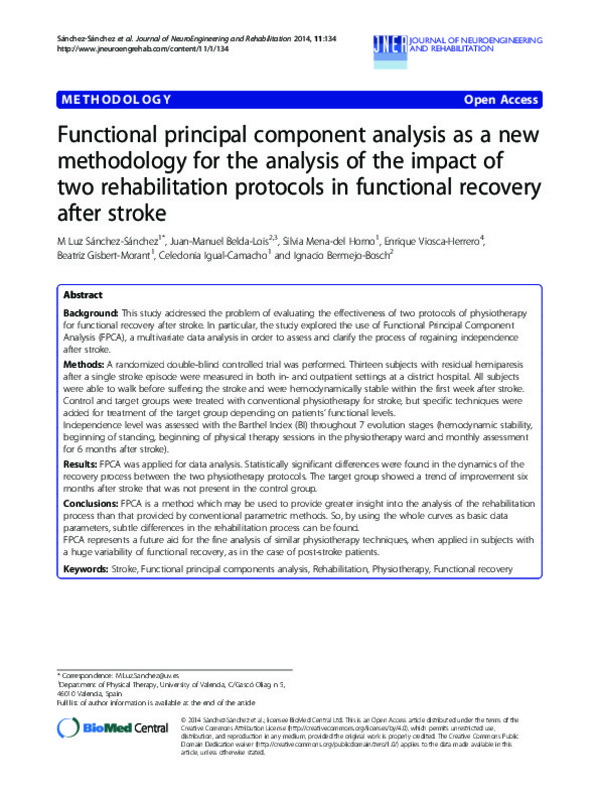JavaScript is disabled for your browser. Some features of this site may not work without it.
Buscar en RiuNet
Listar
Mi cuenta
Estadísticas
Ayuda RiuNet
Admin. UPV
Functional principal component analysis as a new methodology for the analysis of the impact of two rehabilitation protocols in functional recovery after stroke
Mostrar el registro sencillo del ítem
Ficheros en el ítem
| dc.contributor.author | Sánchez-Sánchez, M.L:
|
es_ES |
| dc.contributor.author | Belda Lois, Juan Manuel
|
es_ES |
| dc.contributor.author | Mena Del Horno, Silvia
|
es_ES |
| dc.contributor.author | Viosca Herrero, Enrique
|
es_ES |
| dc.contributor.author | Gisbert-Morant, B.
|
es_ES |
| dc.contributor.author | Igual-Camacho, C.
|
es_ES |
| dc.contributor.author | Bermejo Bosch, Ignacio
|
es_ES |
| dc.date.accessioned | 2016-06-13T10:57:37Z | |
| dc.date.available | 2016-06-13T10:57:37Z | |
| dc.date.issued | 2014-09-10 | |
| dc.identifier.issn | 1743-0003 | |
| dc.identifier.uri | http://hdl.handle.net/10251/65742 | |
| dc.description.abstract | [EN] Background: This study addressed the problem of evaluating the effectiveness of two protocols of physiotherapy for functional recovery after stroke. In particular, the study explored the use of Functional Principal Component Analysis (FPCA), a multivariate data analysis in order to assess and clarify the process of regaining independence after stroke. Methods: A randomized double-blind controlled trial was performed. Thirteen subjects with residual hemiparesis after a single stroke episode were measured in both in- and outpatient settings at a district hospital. All subjects were able to walk before suffering the stroke and were hemodynamically stable within the first week after stroke. Control and target groups were treated with conventional physiotherapy for stroke, but specific techniques were added for treatment of the target group depending on patients' functional levels. Independence level was assessed with the Barthel Index (BI) throughout 7 evolution stages (hemodynamic stability, beginning of standing, beginning of physical therapy sessions in the physiotherapy ward and monthly assessment for 6 months after stroke). Results: FPCA was applied for data analysis. Statistically significant differences were found in the dynamics of the recovery process between the two physiotherapy protocols. The target group showed a trend of improvement six months after stroke that was not present in the control group. Conclusions: FPCA is a method which may be used to provide greater insight into the analysis of the rehabilitation process than that provided by conventional parametric methods. So, by using the whole curves as basic data parameters, subtle differences in the rehabilitation process can be found. FPCA represents a future aid for the fine analysis of similar physiotherapy techniques, when applied in subjects with a huge variability of functional recovery, as in the case of post-stroke patients. | es_ES |
| dc.description.sponsorship | This contribution has been carried out with financial support from the European Commission within the Seventh Framework Programme under contract FP7-ICT-2009-247935: BETTER BNCI-dr. The authors wish to thank the Stroke Rehabilitation Team of Hospital Universitari i Politecnic La Fe (Valencia, Spain), specially Dr. M.R. Beseler, physiotherapist M. Matas and physiotherapist A. Estaun. We also gratefully acknowledge patients who have participated in this study with great enthusiasm. | en_EN |
| dc.language | Inglés | es_ES |
| dc.publisher | BioMed Central | es_ES |
| dc.relation.ispartof | Journal of NeuroEngineering and Rehabilitation | es_ES |
| dc.rights | Reconocimiento (by) | es_ES |
| dc.subject | Stroke | es_ES |
| dc.subject | Functional principal components analysis | es_ES |
| dc.subject | Rehabilitation | es_ES |
| dc.subject | Physiotherapy | es_ES |
| dc.subject | Functional recovery | es_ES |
| dc.subject.classification | INGENIERIA MECANICA | es_ES |
| dc.title | Functional principal component analysis as a new methodology for the analysis of the impact of two rehabilitation protocols in functional recovery after stroke | es_ES |
| dc.type | Artículo | es_ES |
| dc.identifier.doi | 10.1186/1743-0003-11-134 | |
| dc.relation.projectID | info:eu-repo/grantAgreement/EC/FP7/247935/EU/BNCI-driven Robotic Physical Therapies in Stroke Rehabilitation of Gait Disorders/ | |
| dc.rights.accessRights | Abierto | es_ES |
| dc.contributor.affiliation | Universitat Politècnica de València. Departamento de Ingeniería Mecánica y de Materiales - Departament d'Enginyeria Mecànica i de Materials | es_ES |
| dc.description.bibliographicCitation | Sánchez-Sánchez, M.; Belda Lois, JM.; Mena Del Horno, S.; Viosca Herrero, E.; Gisbert-Morant, B.; Igual-Camacho, C.; Bermejo Bosch, I. (2014). Functional principal component analysis as a new methodology for the analysis of the impact of two rehabilitation protocols in functional recovery after stroke. Journal of NeuroEngineering and Rehabilitation. 11:1-9. https://doi.org/10.1186/1743-0003-11-134 | es_ES |
| dc.description.accrualMethod | S | es_ES |
| dc.relation.publisherversion | http://dx.doi.org/10.1186/1743-0003-11-134 | es_ES |
| dc.description.upvformatpinicio | 1 | es_ES |
| dc.description.upvformatpfin | 9 | es_ES |
| dc.type.version | info:eu-repo/semantics/publishedVersion | es_ES |
| dc.description.volume | 11 | es_ES |
| dc.relation.senia | 286087 | es_ES |
| dc.identifier.pmid | 25208616 | en_EN |
| dc.identifier.pmcid | PMC4246446 | en_EN |
| dc.contributor.funder | European Commission |








